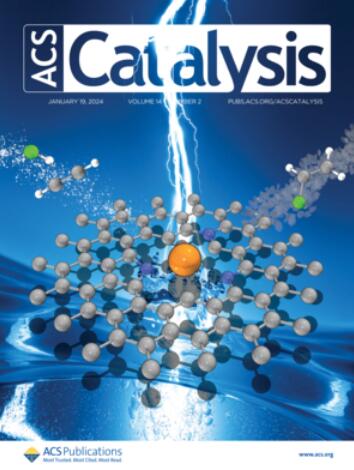Unveiling the Catalytic Mechanism and Conformational Dynamics of Guinea Pig l-Asparaginase Type 1 for Leukemia Drug Design
IF 11.3
1区 化学
Q1 CHEMISTRY, PHYSICAL
引用次数: 0
Abstract
In this study, we present a computational analysis of the catalytic properties of guinea pig asparaginase type 1 (or gpASNase1), an enzyme of mammalian origin that offers a potential alternative for the treatment of acute lymphoblastic leukemia. This enzyme transforms asparagine into aspartate, depriving leukemia cells of this essential amino acid. A combination of molecular dynamics simulations, free energy calculations, and mechanistic insights based on quantum mechanics/molecular mechanics hybrid approaches was used to identify those residues contributing to the catalytic cycle of the enzyme. We dissected the contribution of enzymatic residues to substrate binding and selectivity, showing why this ASNase can degrade asparagine but not glutamine. We also studied the conformational dynamics of the enzymatic loop closing the active site, demonstrating that the substrate binding favors the closed state. The catalytic reaction mechanisms, composed of two stages, acylation and hydrolysis, were explored as well. The rate-limiting step presents a free energy barrier close to the experimental estimation and corresponds to the nucleophilic attack of enzymatic Thr19 on the carbonyl carbon atom of the substrate. Analysis of the electric field created by the protein sheds light on the role of certain residues and structural motifs in stabilizing the reaction transition state. The conclusions of this analysis are useful for rationalizing the properties of chimeras derived from gpASNase1 and predicting additional residue positions, where mutations could enhance substrate binding and loop dynamics. The results of this study enhance the understanding of gpASNase1, offering valuable insights into rational mutations and enzyme engineering for the treatment of leukemia.

揭示豚鼠l-天冬酰胺酶1型在白血病药物设计中的催化机制和构象动力学
在这项研究中,我们对豚鼠1型天冬酰胺酶(或gpASNase1)的催化特性进行了计算分析,这种酶起源于哺乳动物,为治疗急性淋巴细胞白血病提供了潜在的选择。这种酶将天冬酰胺转化为天冬氨酸,使白血病细胞失去这种必需氨基酸。结合分子动力学模拟、自由能计算和基于量子力学/分子力学混合方法的机制见解来识别那些有助于酶催化循环的残基。我们剖析了酶残基对底物结合和选择性的贡献,展示了为什么这种ASNase可以降解天冬酰胺而不能降解谷氨酰胺。我们还研究了关闭活性位点的酶环的构象动力学,证明底物结合有利于关闭状态。探讨了由酰化和水解两个阶段组成的催化反应机理。限速步骤呈现一个接近实验估计的自由能垒,对应于酶促Thr19对底物羰基碳原子的亲核攻击。对蛋白质产生的电场的分析揭示了某些残基和结构基序在稳定反应过渡态中的作用。该分析的结论有助于理顺由gpASNase1衍生的嵌合体的性质,并预测其他残基位置,其中突变可以增强底物结合和环动力学。本研究的结果增强了对gpASNase1的理解,为白血病治疗的合理突变和酶工程提供了有价值的见解。
本文章由计算机程序翻译,如有差异,请以英文原文为准。
求助全文
约1分钟内获得全文
求助全文
来源期刊

ACS Catalysis
CHEMISTRY, PHYSICAL-
CiteScore
20.80
自引率
6.20%
发文量
1253
审稿时长
1.5 months
期刊介绍:
ACS Catalysis is an esteemed journal that publishes original research in the fields of heterogeneous catalysis, molecular catalysis, and biocatalysis. It offers broad coverage across diverse areas such as life sciences, organometallics and synthesis, photochemistry and electrochemistry, drug discovery and synthesis, materials science, environmental protection, polymer discovery and synthesis, and energy and fuels.
The scope of the journal is to showcase innovative work in various aspects of catalysis. This includes new reactions and novel synthetic approaches utilizing known catalysts, the discovery or modification of new catalysts, elucidation of catalytic mechanisms through cutting-edge investigations, practical enhancements of existing processes, as well as conceptual advances in the field. Contributions to ACS Catalysis can encompass both experimental and theoretical research focused on catalytic molecules, macromolecules, and materials that exhibit catalytic turnover.
 求助内容:
求助内容: 应助结果提醒方式:
应助结果提醒方式:


